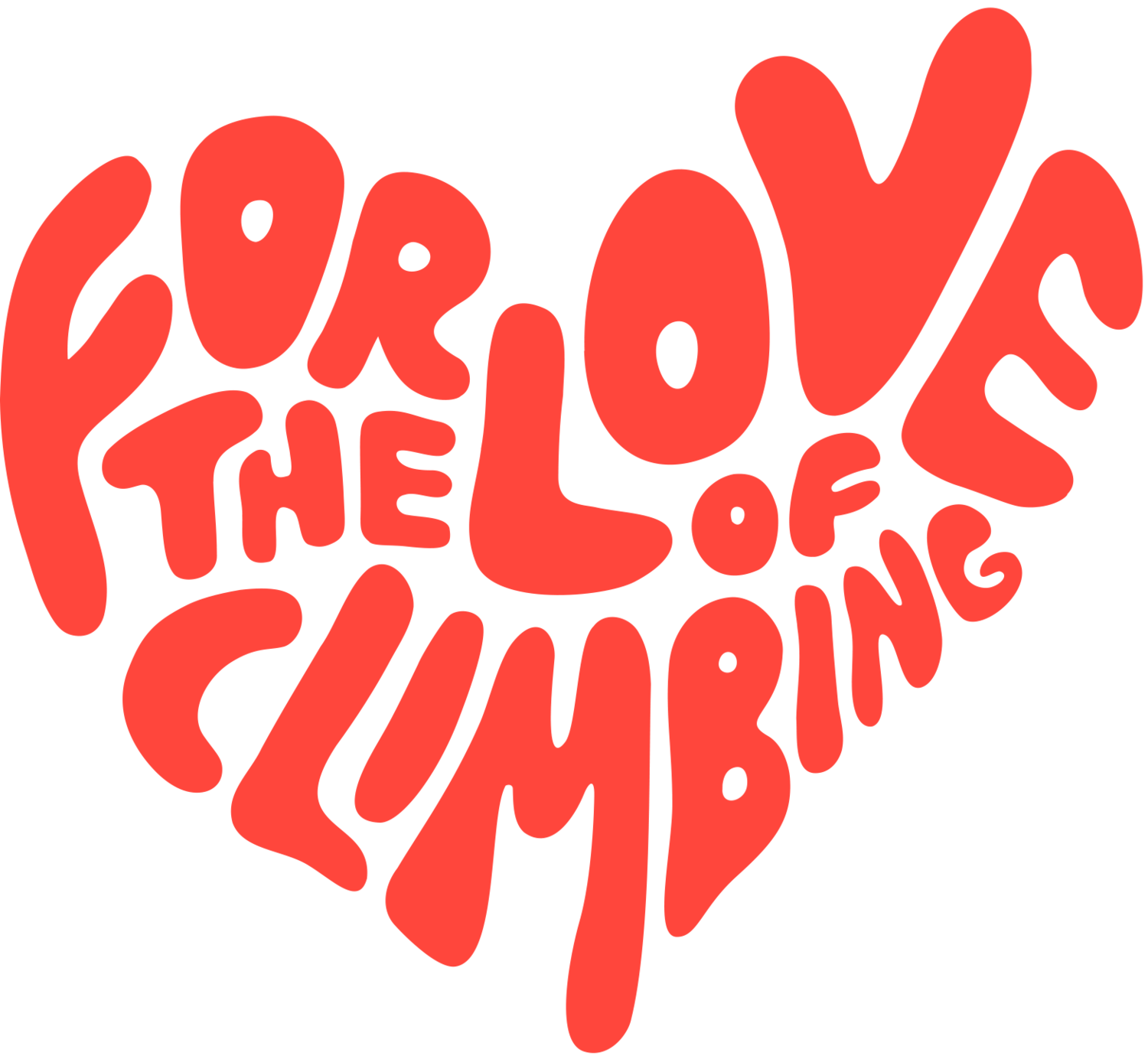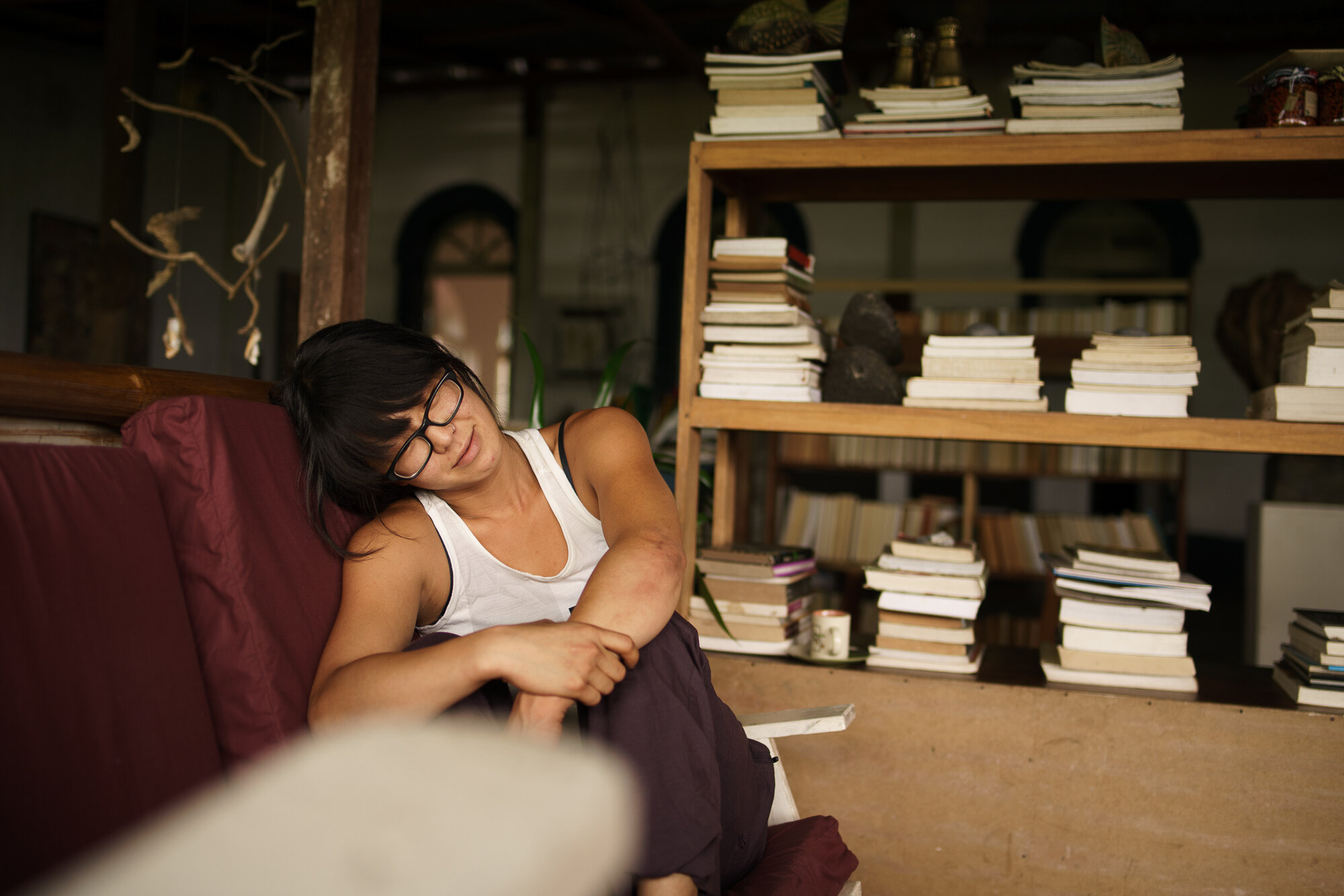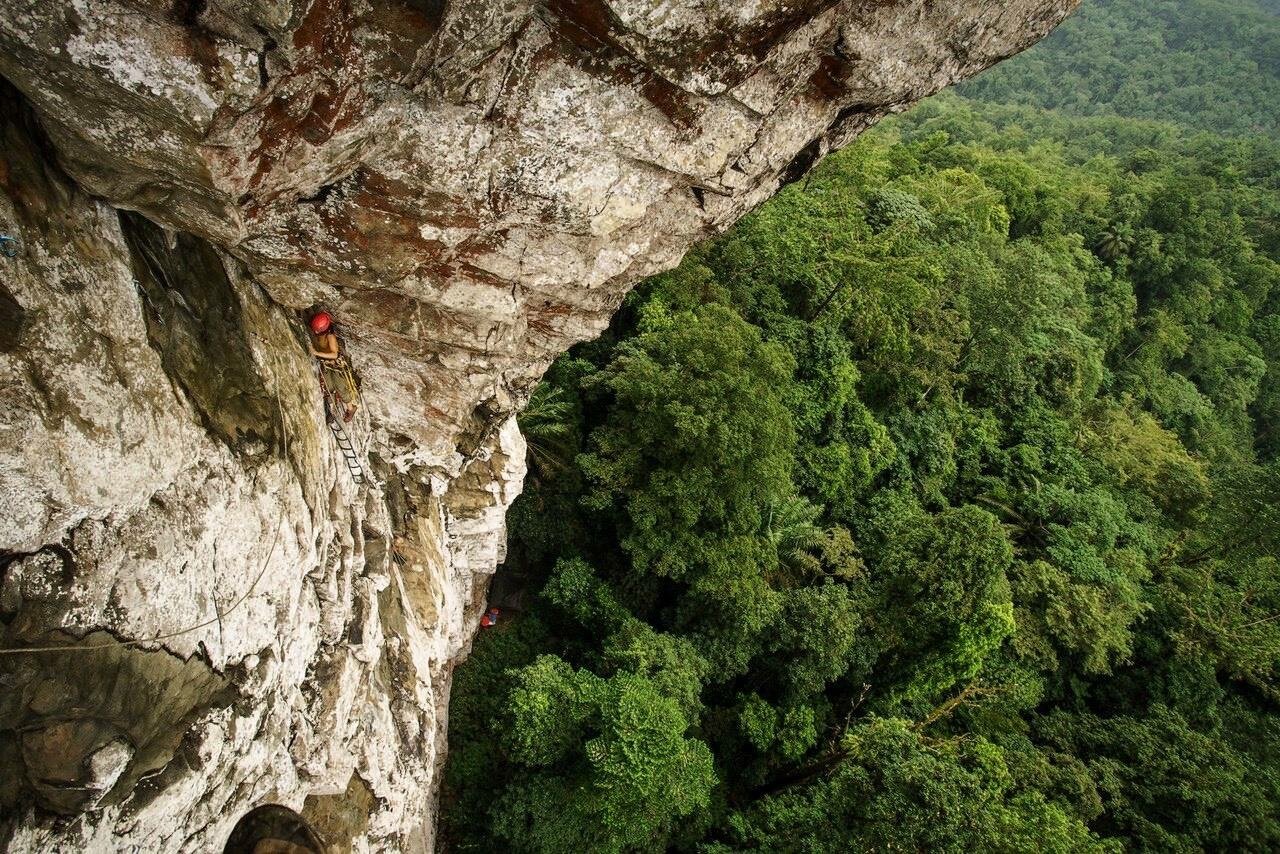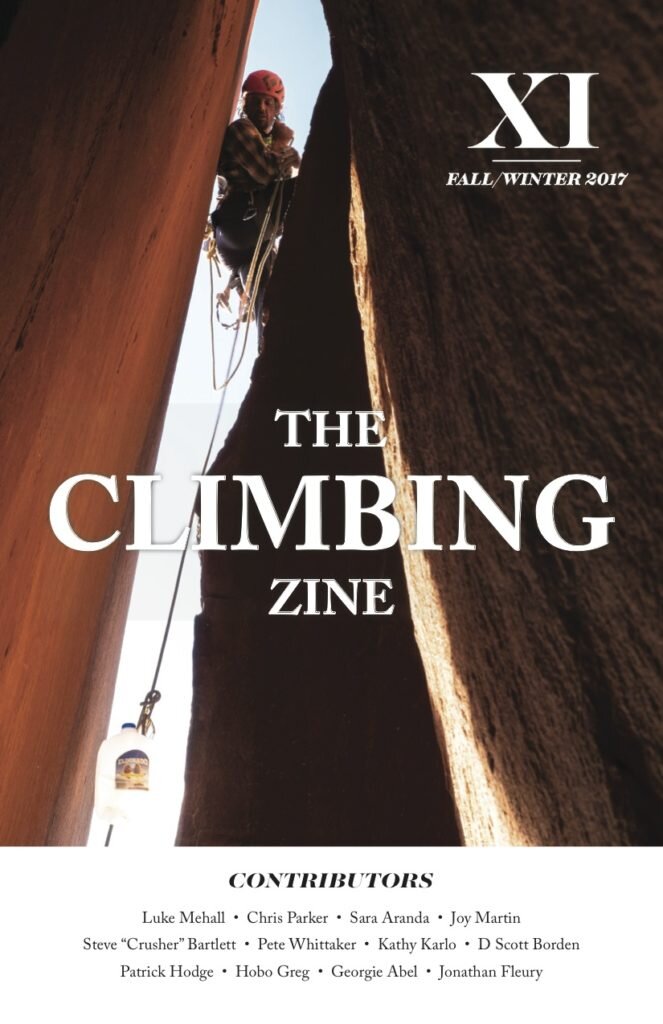Do Not Go Outside to Cry
Photograph courtesy of Irene Yee
This piece is published in The Climbing Zine Volume 11, now available to order.
I see it being used all around me to describe women, often by other women: badass. I have always considered it to have a good connotation, as it implies confidence with a splash of style. Diverse, strong-willed women deserve an empowering word that delivers a heavy compliment—one that says, “She’s got things under control.” The implication is that a person owns who they are without question, completely in command of the direction they are heading in, or as one might say, “She’s a bad mama jama!”
My friend, Alex Theran, a fellow climber, shared her thoughts with me on the implications of being called a badass. She wrote,
“I often plaster my social media with smiles. I erase the memories of very real struggles with a steady stream of upbeat posts and exclamation marks. I wonder if in doing that, I [am making other] women who do have a hard time think that they are failing and that they aren’t cut out for it. Whether ‘it’ is aid work or big wall climbing—messing up, underestimating yourself, overestimating yourself—it’s all part of the process of learning.”
According to the Merriam-Webster Dictionary, a badass is someone who is “ready to cause or get into trouble” or someone “of formidable strength and skill.” Urban Dictionary’s definition tells us that a badass is the “epitome of the American male.” Perhaps several years ago, given the context, it might not have been considered a compliment for women to be called badass; however, the word has undergone a regendering since its birth in the 1950s. While it once celebrated the gunslinging, booze-swigging, rebellious tough guy, badass is now being used to praise strong female characters who are generally bold in many, if not all, facets of life. Amid today’s Walter Whites, John Waynes, and Han Solos, we are seeing a rise in real-life public Katniss Everdeens, more than ever before.
We have Steph Davis, Lynn Hill, Emily Harrington. We have Megan Hine, the daring woman behind Bear Grylls; Balkissa Chaibou, the ambitious sixteen-year-old who is campaigning to end forced marriage; Malala Yousafzai, who survived a gunshot to the head, defied the Taliban in Pakistan, and is a children’s and women’s right’s activist. Not to mention that we had a 2016 female presidential candidate for a major national party, US women flew home with more medals than men after the Olympics in Rio this past summer, and one of the strongest climbers in the world, Ashima Shiraishi, is a sixteen-year-old girl. Today, we continue to work on closing the pay gap between men and women, there are far less fictional designated damsels in distress, and there are more women now than ever before leading our legislative conversation toward real progress.
There is no question about it: being labeled a badass is considered a heavy compliment. Personally, I have always found it flattering anytime someone has used that word to describe me. A badass is considered a tough and uncompromising person, and I can often be both of these things. However, by using this word, are we asking strong women to prove something? Was Alex right about failing to live up to such a high caliber—does the word badass create pressure to maintain that status? Does it create an unreasonable expectation of ourselves and of each other? Language shapes our perceptions and constructs the world we live in, right down to our internalized reactions. Expectations create a form of reality that isn’t actuality. Expectations are problematic because they can often be unrealistic, which leads to disappointment.
In May of 2016, I went on a four-week expedition to Africa with an all-male team of three. Originally, I had declined the offer, aware that I did not possess the necessary skills for establishing a big wall first ascent. Everyone is afraid of big wall, I was told; it was ok to feel afraid. “You might not be a badass big wall climber when we are done. But you will be a big wall climber.”
Though I have rarely been accused of being a fragile person, I felt a huge desire to demonstrate that I was as tough as every member of the team. Working alongside some of the best wall climbers, it was hard not to feel like a total badass by proxy. When asked to join the team, I was told that I had an admirably high tolerance for suffering, which would be crucial to establishing a big wall first ascent.
When we first arrived at São Tomé and Príncipe, an African nation close to the equator, there was a constant buzz of excitement mingled with trepidation—my own. Traveling to a beautiful, remote island in Africa brought me back to memories of my trip to Tanzania, one year prior. My first trip to Africa did not change me in any of the ways I had been expecting; it prepared me. It prepared me to be uncomfortable, ask questions, listen, and be willing to learn.
The culture of São Tomé was rich, colorful, and chaotic. The island is part of a volcano chain featuring a biodiverse jungle preserve and Pico Cão Grande, our objective. There are so few formations in the world like this, and we would be climbing one of the most remote ones. Pico Cão Grande, a needle-shaped plug on the south of São Tomé Island in Obo National Park, is perhaps even more impressive than the Devils Tower in Wyoming. The massive formation is surrounded by jungle and hidden in a constant thick fog of clouds. As far as we knew, nobody had summited its peak except for a local in 1972, by means of grappling hooks and a ladder system. The goal was to establish a free route, and although locals spoke of a Spanish team, they had been unsuccessful.
The entire island and its people had an organized chaos to it, as well as a set of unspoken and unwritten rules. It was wild. I was impressed by the way the people of São Tomé lived off of the land. Even small, basic tasks seemed so much harder. It was a primal way of living, much more than anything I’d experienced being on the road solo for a year.
The women, especially, in Africa are beautiful and bold in a way words will never do justice. They are warrior women, and as we charged down the narrow road in our beast of a Land Cruiser, I closed my eyes and wished I could be like that. We drove on, and my feelings of apprehension accrued as the women grew smaller in the distance, babies strapped to their backs in colorful swaddles, heavy baskets balanced precariously atop their heads, and machetes that could cut your limbs clear off hanging innocently at their sides.
I began questioning why I said yes to an expedition in the first place. I reminded myself that I wasn’t recruited for my aid climbing skills or rigging abilities, nor did I climb 5.13 limestone. In fact, those were all things I was unqualified for, but that’s why I agreed—to experience something new. To take advantage of an opportunity that I would probably never have again and that ninety-nine percent of people would never get in the first place. Our first night at basecamp, the team leader told me to throw my feelings of inadequacy out the window and said, “I asked you here because I knew what you were capable of.”
However, expecting to learn how to big wall climb on a big wall expedition and be good at it was completely unrealistic. Big wall climbing came easily to the team; meanwhile, everything I did, from cleaning pitches to jugging fixed lines, was comparatively slow. Trundling massive death blocks into the jungle and hauling bags was grueling work, both physically and mentally, and I lacked the bandwidth for much of the labor required to get to the top. Toward the end, the difference between feeling twelve steps behind and being left behind became apparent, and I labeled myself a failure. Many times throughout the expedition, I refused to cry in front of the team. I would hold back tears. Over the course of several weeks, this left me spiraling down a very lonely path.
Descending into the jungle to the wall, we often hiked with local guides. They knew the path well and did it gracefully (wearing flip flops instead of the Wellington boots we’d purchased for protection against snake bites), whereas I bumbled along the trail, lucky to have a pole for balance. I watched Mito, one of our guides, cut through the jungle, making new steps for us with his machete, as the old ones had been washed away in the rain. Trudging through the thick jungle felt like vertical swimming. Below the peak, the roots beneath the earth overtook the jungle floor, and because I was afraid of fumbling (and I did, often), I kept my eyes to the ground and was able to collect small mementos along the trail.
I was starting to jug pitches faster but was still slow in comparison. The team was basically jugging hundreds and hundreds of feet, and I could not keep up. I tried to be meticulous with scrubbing (having never done this before, I wanted everything to be perfect, so I simply took too long). Everything I did was slow. Everything I did was stupid. I felt stupid. I felt awkward. I was inadequate, and I knew it, and the guys knew it; everybody knew it. Every day felt like full exhaustion, and I still wasn’t doing enough. Every night I closed my eyes and kept telling myself, With a little extra sleep and a little more determination in the morning, tomorrow will be a better day.
It was something around a battery-charger malfunction that the entire dynamic of the group had shifted. It’s such a small thing, but the reality of being the only woman felt like an inconvenience. I was physically far away from everyone I knew and loved and started feeling it. From a distance, we had scoped out the peak with binoculars, and I remember watching the falcons floating through the sky; I have always wanted to be a bird (specifically a red-tailed hawk) and ride thermals all day, and in that moment, I wanted to be a bird and fly as far away as possible.
One evening, as I was helping to fill a container with gasoline, some spilled on my hand. An hour later, I mentioned that it still smelled and was gruffly told not to complain about things you can change. A part of me felt like saying, “Look at all of the things I haven’t complained about yet!” Instead, I meekly said that I wasn’t trying to be a complainer, and I was sorry. I went to bed early.
I sat at the belay one afternoon, nerves a wreck and feeling like crying and throwing up at the same time. I had never done a lower out before, and this one was huge. One of the team members instructed me how to by shouting from a pitch above, yelling at me not to bounce too much on the rope because it would surely cut. As quickly as the instructions had come, the voice disappeared, and as much as I tried not to panic, I hung at the belay, taking large gulps of air into my lungs.
I tried but was petrified, and I retreated. I rappelled back down to the ground and tried again the next morning. Even though I was successful, I wallowed in my failure that night at dinner. We ate breadfruit that the porters hiked in for us with olive oil and honey. As I munched the sweet, sticky bread, that isolated feeling crept in again and, this time, would not leave.
In the end, the team leader told me that more was expected of me, and I was not allowed to climb and summit with the team. Instead, I waited at the base, alone and humiliated as I packed up what I could. A day later, a fifteen-pitch climb was established up Pico Cão Grande.
During our goodbyes at the airport, I thanked the leader for giving me an experience that gave me thicker skin. And I meant it in the most genuinely grateful way that I could. He did not reciprocate any kindness and instead asked if I would go back to nannying. “You should. It’s easier.” Those words carved something out of me, and it cut, deep and slow.
When I returned home, I struggled to describe the four weeks of jungle sufferfest. I wanted to share my story, but I didn’t want to reveal the truth. I didn’t want to write about my most vulnerable moments because it meant reliving painful failure. Not only that, but I was averse to asking myself why I felt like I couldn’t express these feelings when they had originally surfaced. I desperately wanted to leave behind huge moments of embarrassment at how hard I had struggled and move on, but the second half of the story would always be missing. And so I sat at my computer, uncertain of being so transparent with not only my physical weaknesses but my emotional weaknesses as well. I sifted through hand-scribbled notes that were written alone on the jungle floor. I forced myself to capture my feelings as accurately as possible.
Alex’s words prompted heavy questions: Why had I been so afraid in the first place? Why was I afraid to reveal parts of who I really was during such an important process? Had I been afraid of showing the world a softer side, or was I more afraid of showing the world that I wasn’t the hard woman I had perceived myself to be (and let myself be perceived by others)?
Throughout my years climbing, I was accustomed to being the “cool” girl in the group, the one who gave no fucks, who tried hard, and at the end of the day, could outeat all of the guys at dinner. These distinguishing characteristics made it easy for me to make friends, and after the Africa expedition, I began to realize why. There is something very appealing about a woman who walks with her head held high, who exercises both strength and power, and in a sense, simply “acts like a man.” She is known as the “cool” girl, a persona that our patriarchal culture has many women feeling like they have to be. The “cool” girl can put back a few with her male counterparts. She laughs at the crude jokes and even makes a few of her own. She shows very little of her feelings, and if she has to cry, she goes outside.
In her post, Theran touches on a complicated issue. She says,
“The problem with being a ‘badass chick’ is that you tend to want the ‘badass’ designation to be louder than the ‘chick.’” Theran continues, “When you fail to live up to invincibility, it can be devastating.”
The “cool girl” persona is something of concern. Shannon Kelly writes about this phenomenon in her essay titled, “An Epic Rant About Gone Girls Epic ‘Cool Girl’ Rant,” for Talking Points Memo, where she explains, “It may begin when we’re young and impressionable and want to make ourselves ‘attractive’ to boys—and the message that being Cool Girl will help you achieve Peak Attractive is everywhere (thank those socially awkward movie-writing men)—but then, what happens? When we grow up and see things in the workplace, in our own families, in society at large and in our own social circles that deserve being called out — rather than doing the calling, is Cool Girl’s pull so strong that, even in the face of the health or safety of our own daughters and sons, we’d rather play it cool? Is that why things don’t change?”
The pressure to prove that, as women, we are as capable as men creates a tendency to internalize a message that tells us that to be strong means to be unbreakable—that being hardcore and showing your feelings cannot coincide. We live in a society that continuously tells us that feminine traits, while expressive and emotionally complex, will not let us succeed. As women continue to carve out a place for themselves in climbing history, there is still an unspoken undertone that we have to remain stoic. Whether or not it’s a self-imposed standard, it creates an immense pressure to downplay the stress, the flaws, and the fuckups.
Professional rock climber Mary Harlan of Carbondale, Colorado, says that in all of her years climbing, female partners have been most harsh on themselves. “If we didn’t accomplish a goal, there tended to be more self-deprecating talk amongst the women versus the men.” The ability to own failure and really talk about it can be much harder for women because of a pre-existing stigma that women are the weaker gender. On failing, Harlan says, “It’s when I am failing and I’m falling apart that I start to realize that the world is trying to teach me something.”
The more I explored what it meant to “act like a man,” the more the gender double-edged sword became revealed to me. Habitual dialogue filled with misogynistic comments such as “man up” or “don’t be so sensitive” is ingrained in our culture from an early age. We’ve heard people cry out, “Don’t be such a girl!” which translates directly to: “Women are weak.”
The word badass reaches its limits in the sense that it implies that we must live up to invincibility. The truth is that we all have our breaking points, regardless of gender, and finding out what they are is what makes us human. Learning from our weak moments is humbling. Allowing ourselves to express our feelings is admitting vulnerability. In my eyes, there is nothing more badass than exposing a weakness.
Failure gives you depth. It gives you mental tenacity. It shatters the expectations we often feel trapped within, the expectations that our perceptions of ourselves create. Exposing our failures lets us fearlessly show the world that we are human. In celebrating those we consider badass, we tend to ignore emotional openness and whitewash over the tears. Let us continue to acknowledge and praise hard work, but remember that it takes more than that to reach a summit. Success doesn’t happen by accident. Nobody walks up the mountain to the top with a smile on their face the entire time, or without shedding a few tears, a little blood. Success is only half of the true story.
In 2014, Hilary Clinton spoke at an event at New York University regarding leadership advice to women. Clinton shared a famous sentiment from Eleanor Roosevelt in the 1920s that expressed “if a woman wants to be involved in the public, she has to grow skin as thick as the hide of a rhinoceros.” Later, in an interview with Time, Clinton went on to elaborate: “So even back then, this was an obvious point of concern and contention. Too many young women are harder on themselves than circumstances warrant. They are too often selling themselves short.…But it is a process.”
It is indeed a process and a slow road to progress. It is the kind of process that warrants many conversations about social categories—categories that come from an uneven gender landscape. We take the first step by acknowledging unfair social structures that women face before we can make any true progress.
For fathers and mothers who have young sons and daughters: Teach your children that they need not fit the cookie-cutter mold of what society believes “strong” men and women look like. Show your daughters that they have a right to a safe place to express their emotional responses, whether it be in the workplace or in the mountains. Show your sons that it is ok to cry.
It’s a tender road we find ourselves on, wanting to be both strong and flexible to those who are watching. As a female climber and a female in general, it becomes a balancing act—learning to be a strong and autonomous person while simultaneously embodying the softer, more vulnerable side of human emotions. I express great gratitude as I applaud a growing feminist society for taking a word once rooted in maleness and turning it into one that empowers women of all generations, but I also ask that we all remember that you can be fierce and vulnerable synchronously. There is no rule that says we must draw a line between the two.
For women who aspire to be first ascensionists, climb big alpine walls, stumble upon uncharted paths: Continue pursuing higher elevations, but do not be afraid to struggle. Do not be shamed into downplaying emotions, especially in difficult moments. Do not go outside to cry. For women who feel outnumbered in their profession, who choose challenging career paths that are both physically and mentally demanding, who feel like showcasing “manliness” is the only way to succeed: Do not strive for less than what you know you can achieve by “manning up” to accommodate anybody. Strive for more, but do not sweep away your emotions. Instead, take your weak moments and turn them into inspiration. Do not go outside to cry.
This article was originally published on For the Love of Climbing, and later edited and published here by The Climbing Zine.
Cover photograph courtesy of Irene Yee. All other photographs courtesy of Matthew Parent






